The Urgent Push for Recycling System Improvements in the US
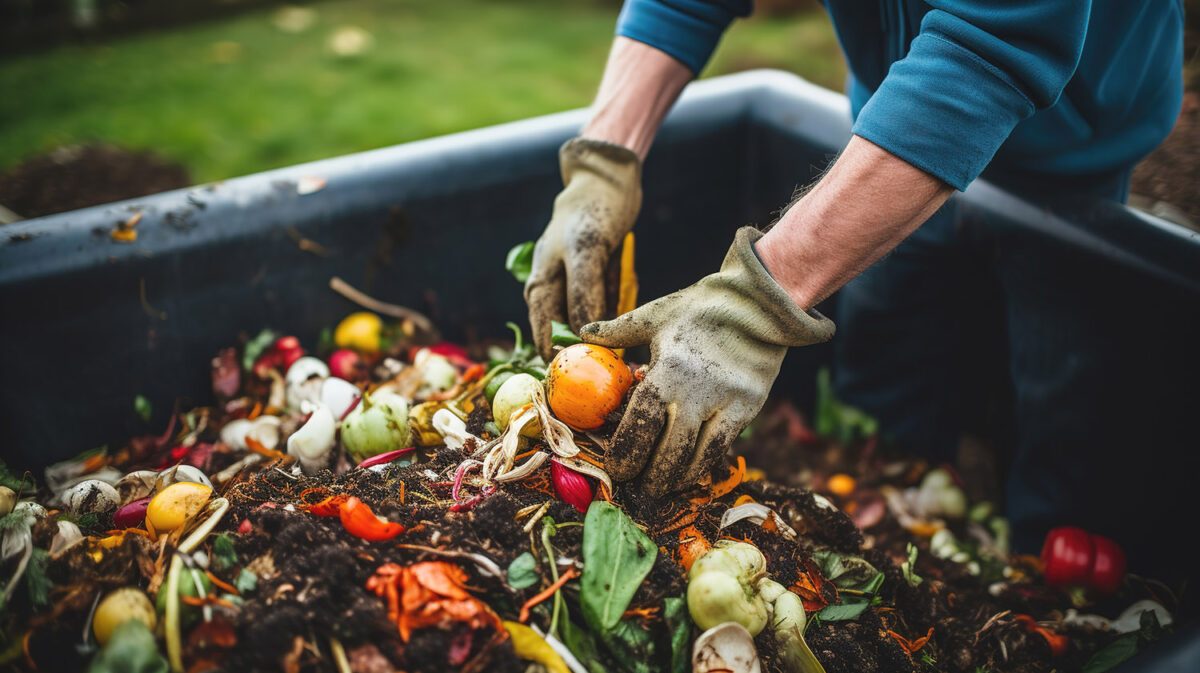
In the face of escalating environmental concerns, the efficacy of recycling systems has never been more critical.
The Recycling Partnership reveals a comprehensive document “The State of Recycling: The Present and Future of Residential Recycling in the U.S. 2024” which shows some insights from the US recycling system, underscoring the necessity for a holistic approach.
You can also read: Flexible and Recyclable: Monomaterial Packaging Meets Sustainability Needs
The document outlines five essential criteria for a successful recycling system that legislators, consumers, and producers must tackle.
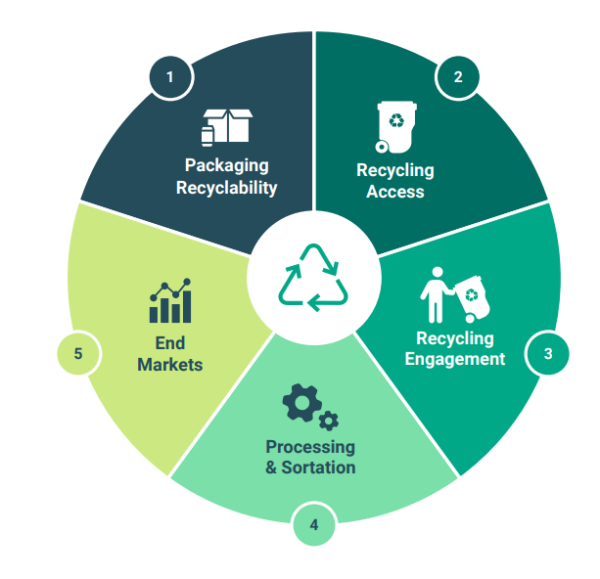
The Five Requirements For An Effective Recycling System. Courtesy of State of Recycling: The Present and Future of Residential Recycling in the U.S. 2024.
1. Packaging Recyclability
The base of an effective recycling system is the recyclability of packaging. Currently, a significant portion of packaging fails to meet recyclable standards, presenting a barrier to sustainability efforts. 100% of packaging needs to be recyclable. Consequently, The system must evolve to design innovations and standardized criteria to elevate packaging recyclability, ensuring materials can re-enter the production cycle with minimal environmental impact.
The U.S. Plastics Pact’s 2021 Annual Report, released in February 2023, reveals a critical snapshot of the current state of plastic packaging sustainability. With 36% of plastic packaging from Pact Members being reusable, recyclable, or compostable, the report underscores a significant journey towards the ambitious 2025 target. This commitment by Pact Members to ensure that 100% of their plastic packaging meets these sustainability criteria by 2025 highlights the urgent need for innovation, collaboration, and systemic changes within the industry.
2. Recycling Access
Access to recycling facilities is paramount. Surprisingly, a substantial number of households, particularly in multifamily settings, lack this basic service. 100% of households need access to recycling from their home. The recycling system needs to bridge the gap so every household can contribute to waste reduction.
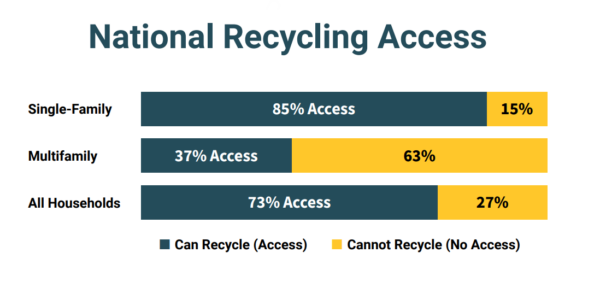
National Recycling Access. Courtesy of State of Recycling: The Present and Future of Residential Recycling in the U.S. 2024.
3. Recycling Engagement
Engagement and education are crucial in encouraging households to recycle effectively. The document emphasizes the need for widespread education campaigns to inform citizens about the benefits of recycling and proper sorting practices. This engagement aims to boost participation rates, ensuring materials are correctly disposed of and processed.
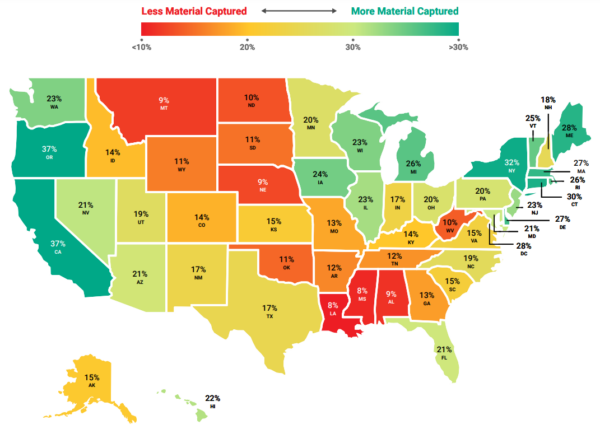
State-by-State Residential Recycling Rates. Courtesy of State of Recycling: The Present and Future of Residential Recycling in the U.S. 2024.
4. Processing & Sortation
Efficient processing and sortation facilities are essential for a functional recycling system. The document highlights the importance of modern Material Recovery Facilities (MRFs) equipped to handle and sort recyclables efficiently. Upgrading these facilities can significantly enhance the quality and quantity of materials recovered, making recycling more economically viable. Despite these efforts, currently, most curbside recycling programs reject film and flexible materials, capturing less than one percent of the nearly 4.8 million tons produced annually. With the increasing presence of film and flexible materials in products, investing in technologies and systems to enhance their recyclability becomes crucial. Industry stakeholders are actively pursuing solutions to better integrate these materials into the recycling process.
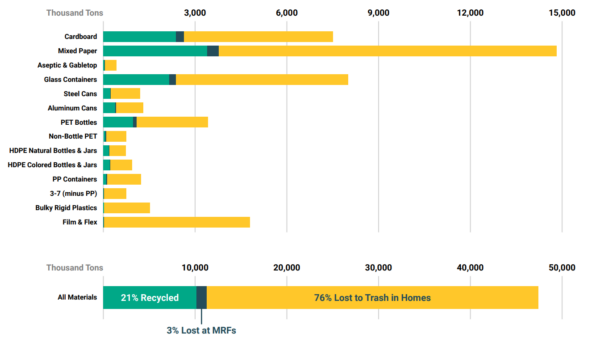
Fate of Material by Major Material Category (in Tons Per Year). Courtesy of State of Recycling: The Present and Future of Residential Recycling in the U.S. 2024.
5. End Markets
Sustainable end markets for recycled materials are crucial for the recycling ecosystem. A strong demand for recycled content in manufacturing can drive the entire recycling process, from collection to processing. Developing and supporting these markets is vital for closing the loop, reducing reliance on virgin materials, and promoting a circular economy. Nevertheless, this is still a challenge due to the volatility of the blended materials value.
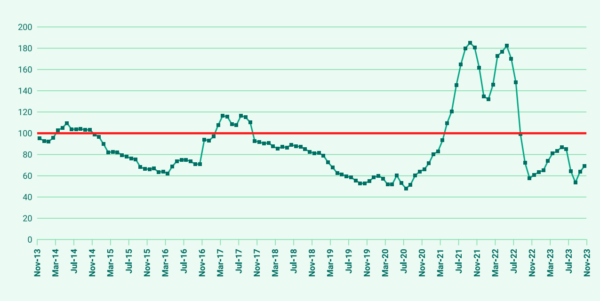
Blended Materials Values for Materials Recovery Facilities. Points are the selling price of the recycled plastic and the red line is the processing cost. Courtesy of State of Recycling The Present and Future of Residential Recycling in the U.S. 2024.
Recycling centers, also known as Material Recovery Facilities (MRFs), are grappling with the challenge that the money they make from selling recycled materials often doesn’t cover their processing expenses. On average, it costs them $100 to process a ton of material. A graph shows that, for the past six years, the selling price of recycled materials has mostly been lower than their processing costs, with the exception of a period from April 2021 to August 2022. This pricing issue could be due to various factors such as changes in global trade, reduced demand from consumers in a slowing economy, and competition from cheaper, newly made (virgin) materials.
In conclusion, an effective recycling system requires integrated efforts across packaging design, access to recycling, public engagement, processing capabilities, and the development of end markets. By addressing these key areas, we can move towards a more sustainable and efficient recycling model that supports environmental conservation and economic growth.
To read the complete report click here.
